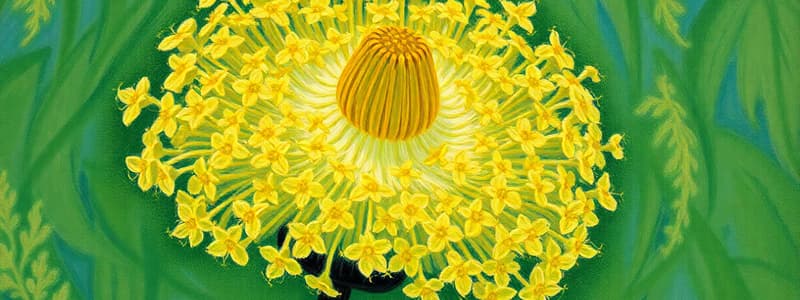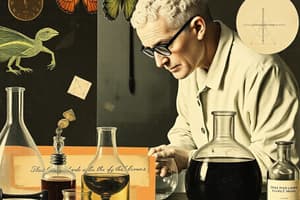Podcast
Questions and Answers
Which element is NOT one of the six that makes up about 99% of living matter?
Which element is NOT one of the six that makes up about 99% of living matter?
- Iron (correct)
- Nitrogen
- Hydrogen
- Oxygen
What determines the chemical properties of an atom?
What determines the chemical properties of an atom?
- The number of protons it has
- The mass of the nucleus
- The distribution of electrons (correct)
- The temperature of the atom
What type of bond occurs when electrons are shared equally between atoms?
What type of bond occurs when electrons are shared equally between atoms?
- Hydrogen bond
- Polar covalent bond
- Ionic bond
- Nonpolar covalent bond (correct)
Which property of water is responsible for its ability to moderate temperature?
Which property of water is responsible for its ability to moderate temperature?
Why does ice float on top of liquid water?
Why does ice float on top of liquid water?
What is the pH range of most cells, which is critical for biochemical processes?
What is the pH range of most cells, which is critical for biochemical processes?
What is the impact of increasing atmospheric CO2 on coral reefs?
What is the impact of increasing atmospheric CO2 on coral reefs?
Which of the following describes the behavior of hydrogen bonds in liquid water?
Which of the following describes the behavior of hydrogen bonds in liquid water?
What is the primary focus of science as outlined in the content?
What is the primary focus of science as outlined in the content?
Which of the following correctly describes emergent properties in biological organization?
Which of the following correctly describes emergent properties in biological organization?
Which statement accurately describes natural selection?
Which statement accurately describes natural selection?
In the context of experimental design, what distinguishes a manipulative experiment from a natural experiment?
In the context of experimental design, what distinguishes a manipulative experiment from a natural experiment?
Which domain of life includes organisms with complex cells?
Which domain of life includes organisms with complex cells?
What role does a hypothesis play in scientific inquiry?
What role does a hypothesis play in scientific inquiry?
What is the simplest structural and functional unit of life?
What is the simplest structural and functional unit of life?
Which of the following is a characteristic of elements in biological compounds?
Which of the following is a characteristic of elements in biological compounds?
Which statement accurately describes a compound?
Which statement accurately describes a compound?
What primarily determines the chemical properties of organic molecules?
What primarily determines the chemical properties of organic molecules?
Which type of structure does cellulose represent in plants?
Which type of structure does cellulose represent in plants?
What is the primary role of fats in living organisms?
What is the primary role of fats in living organisms?
Which statement about ions is accurate?
Which statement about ions is accurate?
How do monosaccharides differ from polysaccharides?
How do monosaccharides differ from polysaccharides?
Which of the following correctly describes surface tension?
Which of the following correctly describes surface tension?
What is the relationship between hydrocarbons and carbon-based compounds?
What is the relationship between hydrocarbons and carbon-based compounds?
Flashcards
Atoms
Atoms
The fundamental units of matter, composed of protons, neutrons, and electrons.
Chemical bonds
Chemical bonds
Attractions between atoms that result from sharing or transferring electrons.
Covalent bonds
Covalent bonds
Chemical bonds formed by electron sharing between atoms.
Ionic bonds
Ionic bonds
Signup and view all the flashcards
Hydrogen bonds
Hydrogen bonds
Signup and view all the flashcards
Water's cohesion
Water's cohesion
Signup and view all the flashcards
Water as a solvent
Water as a solvent
Signup and view all the flashcards
pH scale
pH scale
Signup and view all the flashcards
What is a compound?
What is a compound?
Signup and view all the flashcards
What is the smallest unit of matter?
What is the smallest unit of matter?
Signup and view all the flashcards
What are chemical bonds?
What are chemical bonds?
Signup and view all the flashcards
What is an ion?
What is an ion?
Signup and view all the flashcards
What is a hydrocarbon?
What is a hydrocarbon?
Signup and view all the flashcards
What are isomers?
What are isomers?
Signup and view all the flashcards
What are carbohydrates?
What are carbohydrates?
Signup and view all the flashcards
What are lipids?
What are lipids?
Signup and view all the flashcards
What is Biology?
What is Biology?
Signup and view all the flashcards
Properties of Life
Properties of Life
Signup and view all the flashcards
What's the smallest unit of life?
What's the smallest unit of life?
Signup and view all the flashcards
Three Domains of Life
Three Domains of Life
Signup and view all the flashcards
Hierarchy of Life
Hierarchy of Life
Signup and view all the flashcards
Emergent Properties
Emergent Properties
Signup and view all the flashcards
Science: Evidence-based Inquiry
Science: Evidence-based Inquiry
Signup and view all the flashcards
Scientific Theory
Scientific Theory
Signup and view all the flashcards
Study Notes
Chapter 1: Introduction to Biology
- Biology is the scientific study of life, encompassing order, reproduction, growth/development, energy processing, regulation, response to the environment, and evolutionary adaptation.
- The cell is the fundamental structural and functional unit of life.
- Life is organized hierarchically: biosphere, ecosystem, community, population, organism, organ system, organ, tissue, cell, organelle, molecule.
- Emergent properties arise from interactions among component parts at each level of biological organization.
- Science uses an evidence-based process of inquiry to investigate the natural world, involving observations, hypotheses, predictions and tests (through experiments or further observation), and analysis of data.
- Scientific theories are broad in scope and supported by a large body of evidence.
- Hypotheses are tested using controlled experiments.
- Hypotheses can also be tested using observational data.
- Hypotheses about evolutionary relationships can be tested by comparing DNA sequences.
- Natural selection is a process resulting in adaptation by selectively reproducing changes in an organism's genotype.
Chapter 2: Chemical Concepts in Biology
- Organisms are composed of elements, with oxygen, carbon, hydrogen, nitrogen, calcium, and phosphorus comprising most of living matter.
- Atoms consist of protons, neutrons, and electrons.
- Radioactive isotopes are valuable in research and medicine.
- Atoms bond to form molecules via chemical bonds.
- Covalent bonds form by sharing electrons.
- Ionic bonds form through the attraction of oppositely charged ions.
- Hydrogen bonds are weak attractions between molecules.
- Chemical reactions involve the making and breaking of chemical bonds.
- Water has properties that are crucial for life: cohesion, high specific heat, high heat of vaporization, and density (ice floats).
- Water is the universal solvent.
- Cohesion helps water move in plants.
- Water moderates temperature.
- Aqueous solutions are important in biological systems.
Chapter 3: The Molecules of Life
- Life's molecular diversity is due to carbon's ability to form four covalent bonds.
- Hydrocarbons consist solely of carbon and hydrogen.
- Isomers have the same molecular formula but different structures.
- Chemical groups attached to carbon skeletons impart specific chemical properties.
- Cells make large molecules from small monomers.
- Carbohydrates are composed of carbon, hydrogen, and oxygen (CH2O) in a 1:2:1 ratio.
- Monosaccharides are simple sugars; disaccharides and polysaccharides are complex carbohydrates.
- Fats (triglycerides) are the main energy storage form in animals.
- Phospholipids are critical components of cell membranes.
- Steroids have diverse functions and include cholesterol.
Chapter 4: Cells: The Fundamental Units of Life
- Microscopes enable visualization of cells and their internal structures (ultrastructure).
- Cell size is vital for material exchange.
- Prokaryotic cells lack membrane-bound organelles.
- Eukaryotic cells are compartmentalized.
- The nucleus contains DNA.
- Ribosomes are the sites of protein synthesis.
- The endomembrane system includes components like the endoplasmic reticulum, Golgi apparatus, and lysosomes.
- Mitochondria are the organelles of cellular respiration.
- Chloroplasts carry out photosynthesis.
- Cell walls enclose and support plant cells.
Chapter 5: Membrane Structure and Function
- Membranes are fluid mosaics of lipids and proteins.
- Membranes form spontaneously.
- Passive transport is the movement of substances across membranes without energy input.
- Osmosis is the diffusion of water across a membrane.
- Active transport requires energy to move substances against their concentration gradient.
- Exocytosis and endocytosis are methods for transporting large molecules across the plasma membrane.
- Cells transform energy through chemical reactions.
Chapter 6: Cellular Respiration and Fermentation
- Photosynthesis uses solar energy to produce organic molecules.
- Cellular respiration breaks down organic molecules to release energy.
- Breathing provides oxygen for cellular respiration and removes carbon dioxide.
- Cellular respiration primarily occurs in mitochondria.
- Glycolysis, the citric acid cycle, and oxidative phosphorylation are three main stages of cellular respiration, producing ATP.
Studying That Suits You
Use AI to generate personalized quizzes and flashcards to suit your learning preferences.




